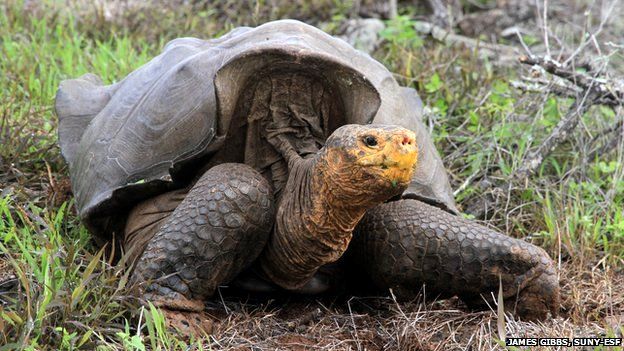Giant tortoise makes 'miraculous' stable recovery
- Published

Where once there were 15, now more than 1,000 giant tortoises lumber around Espanola, one of the Galapagos Islands.
After 40 years' work reintroducing captive animals, a detailed study of the island's ecosystem has confirmed it has a stable, breeding population.
Numbers had dwindled drastically by the 1960s, but now the danger of extinction on Espanola appears to have passed.
Galapagos tortoises, of which there are 11 remaining subspecies, weigh up to 250kg and live longer than 100 years.
The study, based on decades of observations of the variety found on Espanola, was published in the journal Plos One.
Slow release
It offers some good news that contrasts with the tale of Lonesome George, the very last of the related subspecies found on Pinta, on the other side of the archipelago. George's death, at the age of about 100, made international news in 2012.
Lead author Prof James Gibbs told BBC News the finding on Espanola was "one of those rare examples of a true conservation success story, where we've rescued something from the brink of extinction and now it's literally taking care of itself".
Prof Gibbs, from the College of Environmental Science and Forestry at the State University of New York (SUNY-ESF), said he felt "honoured" to be reporting the obvious success of the reintroduction programme, which the Galapagos Islands National Park Service commenced in 1973.
His team has found that more than half the tortoises released since that time are still alive, and they are breeding well enough for the population to plod onward, unaided.
"It looks like we can step back out of the picture," Prof Gibbs said.
It is quite a contrast to the 1960s, when just 12 females and 3 males roamed the island.
"They were so rare at that point, they couldn't find one another. Many of the females had lichens growing on their backs, and fungi, that indicated they hadn't been mated in a very long time."
Those animals were taken to an enclosure another island, to concentrate on breeding. Over the subsequent decades, more than 1500 of their captive-raised offspring have been released on Espanola.
Competing for cacti
It wasn't as simple as putting the tortoises back, however. Their problems began when feral goats were introduced in the 1800s and devoured much of the island's vegetation, severely disrupting the ecosystem.
"They can literally turn a rich ecosystem into a dustbowl," Prof Gibbs said.
The goats even learned to feast on very tall cactus plants, whose dropped pads are a key food source for the tortoises in the dry season.
"They would feast on the roots... and chew away at the bark, and eventually that would topple these cacti. And then they had an incredible buffet of maybe 500-1000 years of cactus growth, demolished in a week or two."
Conservationists set about culling the goats in the 1970s and finally eradicated them in the 1990s.
Their legacy, Prof Gibbs discovered, remains.
Analysis of the island's plant life and its soil show that it has seen a major shift to bigger, woodier vegetation in the 100 years since the goats started stripping the undergrowth.
These shrubs and trees are a problem both for the tortoises and for their summer food of choice, the cacti.
The trees even get in the way of an endangered albatross that breeds on the island, making it difficult for the big, ungainly birds to take flight.
"Population restoration is one thing but ecological restoration is going to take a lot longer," Prof Gibbs said.
Dr Rebecca Scott, an ecologist who studies turtles at GEOMAR in Kiel, Germany, said the results showed how important it is to monitor reintroduction carefully.
"Reintroducing these large, keystone species, in combination with reducing the spread of invasive species, can really help return ecosystems to native state.
"This work highlights the merit of well-managed reintroduction programmes, but also of really monitoring how these animals do."
Dr Gerardo Garcia, a herpetologist at Chester Zoo, agreed that the situation was complex and the programme had succeeded because of careful, long-term management.
"It's a long process but it's quite normal for it to take decades," he told BBC News.
"Nothing gets released and stable in less than 20 or 30 years."
Follow Jonathan on Twitter
- Published22 September 2014
- Published10 October 2014
- Published23 October 2014
- Published13 March 2014
- Published28 June 2012